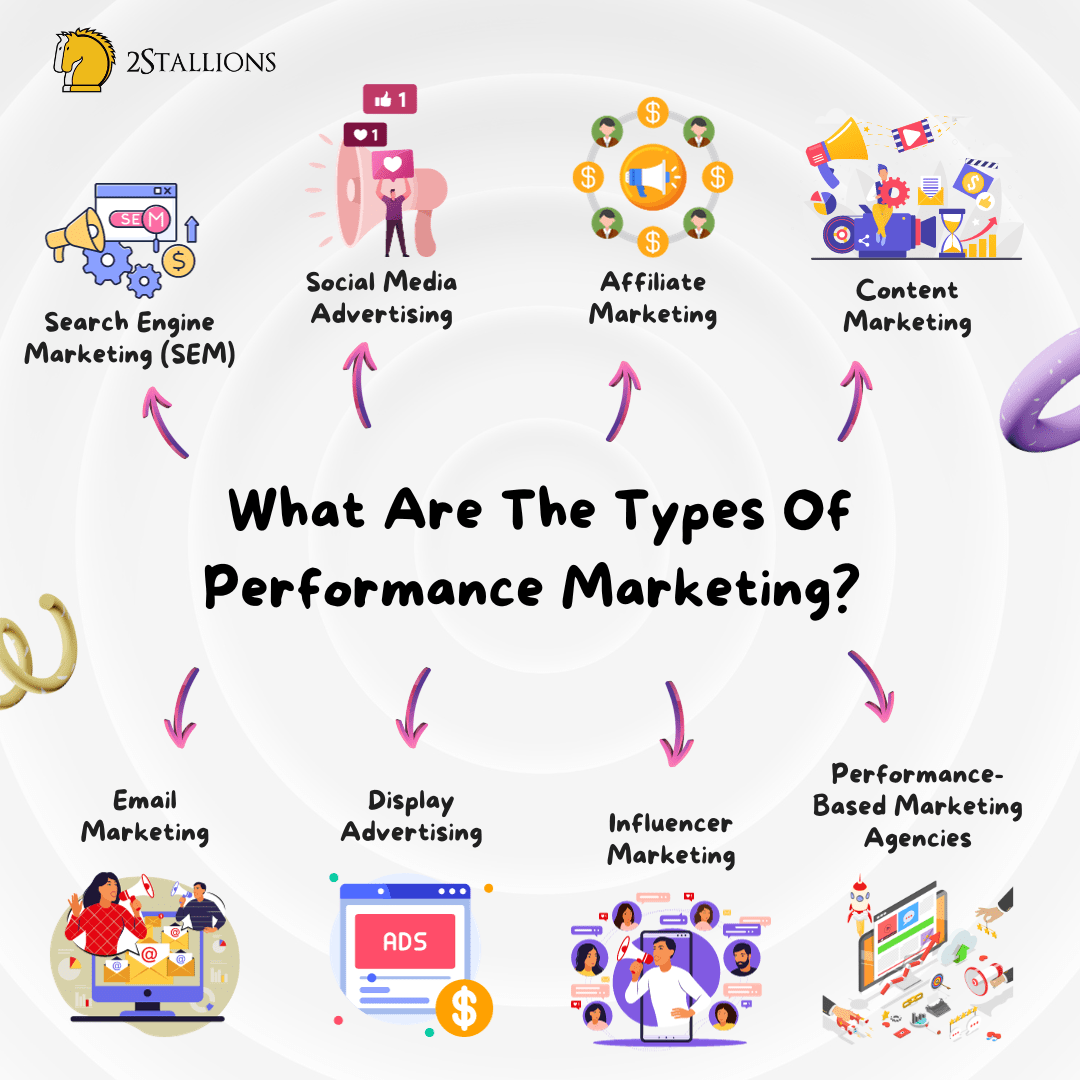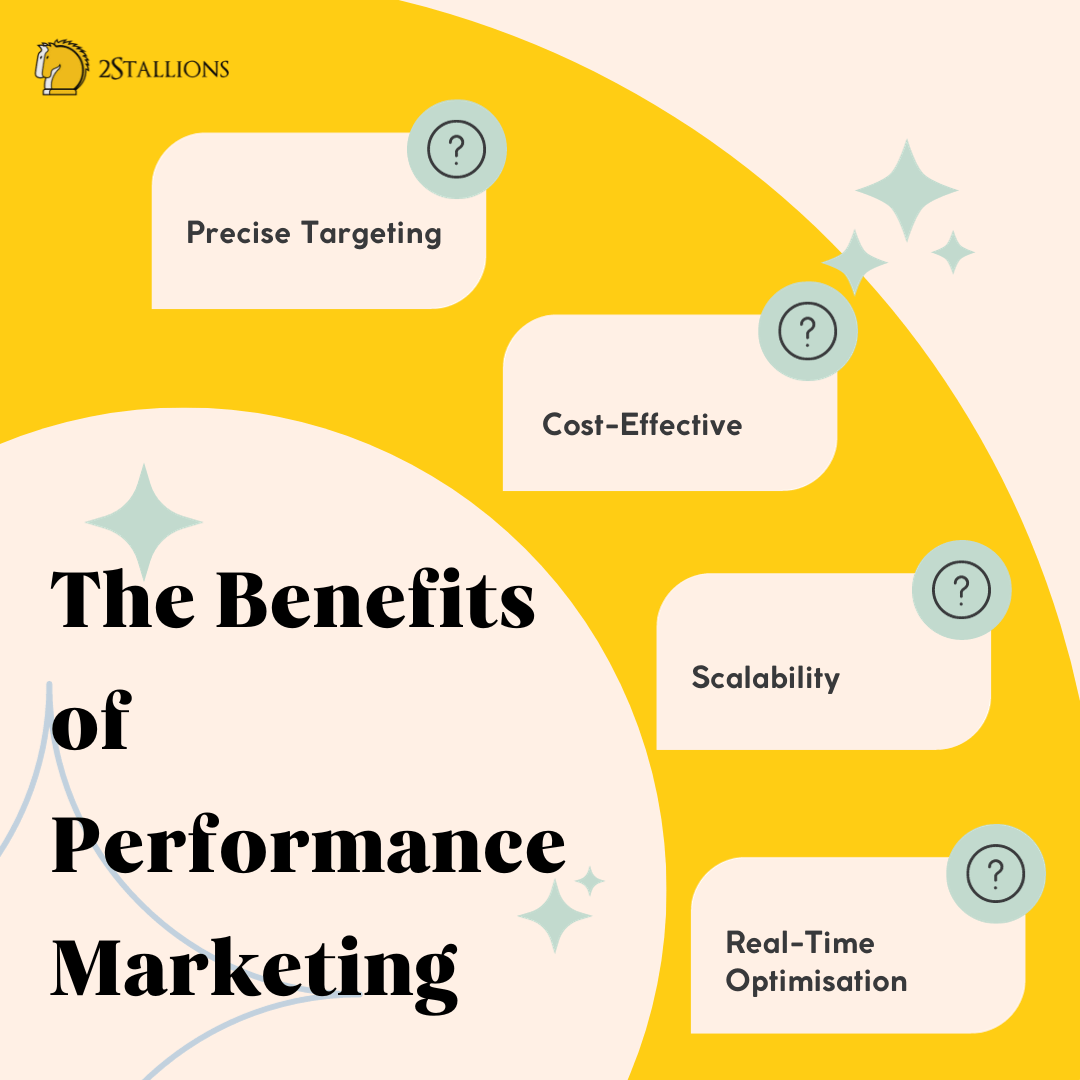SHARE

In the ever-evolving digital advertising landscape, understanding the nuances of advertising performance is essential. Whether you’re looking to explore performance marketing channels, seek the expertise of a performance-based marketing agency, or enhance your strategies with performance marketing services, you’ve come to the right place.
[thrive_leads id=’8346′]
What Is Performance Marketing?
Performance marketing is a digital strategy focused on achieving specific, quantifiable results. Performance marketing delivers tangible outcomes, unlike traditional advertising methods prioritising brand awareness or engagement. These outcomes include lead generation, sales, website visits, or other desired actions.
What Are The Types Of Performance Marketing?
Performance marketing is a dynamic and results-driven approach that has gained significant traction in digital advertising. This strategy focuses on delivering measurable outcomes, encompassing various performance marketing channels and performance marketing services.
Search Engine Marketing (SEM)
SEM is a prominent performance marketing channel that involves paid advertising on search engines like Google and Bing. Marketers bid on keywords to ensure their ads appear when users search for specific terms, making it a precise and accountable approach.
Social Media Advertising
Platforms like Facebook, Instagram, Twitter, and LinkedIn offer extensive performance marketing services. Advertisers can target their audience based on demographics, interests, and behaviours, ensuring ads reach the right people at the right time.
Affiliate Marketing
In this model, businesses collaborate with third-party partners or affiliates who promote their products or services. Affiliates earn a commission for each sale they drive, making it a clear-cut example of performance-based marketing.
Content Marketing
When executed strategically, content marketing can also fall under the umbrella of performance marketing. Brands create valuable content to engage and convert their audience, monitoring key performance metrics such as clicks, conversions, and engagement.
Email Marketing
Email campaigns can be highly targeted, allowing marketers to track open rates, click-through rates, and conversion metrics. This makes it an essential performance marketing channel for businesses seeking direct and measurable results.
Display Advertising
Display ads can be tracked and optimised quickly, making them a powerful performance marketing service. Marketers can continually adjust ad placements, designs, and targeting to enhance performance.
Influencer Marketing
Collaborating with influencers is a prevalent form of performance-based marketing. Brands partner with influencers with a dedicated following to promote their products or services, measuring success through key performance indicators like engagement and conversions.
Performance-Based Marketing Agencies
Performance-based marketing agencies deliver quantifiable results for businesses seeking to outsource their performance marketing efforts. These agencies, including renowned firms such as 2Stallions, leverage diverse performance marketing channels and services to achieve specific objectives. We are experts in data-driven decision-making, working closely with businesses to establish clear goals and track essential Key Performance Indicators (KPIs).
The Benefits Of Performance Marketing
Embracing performance marketing unlocks a treasure trove of benefits for businesses. This dynamic strategy, driven by data and precision, delivers exceptional customer engagement and amplifies revenue. It thrives on the principles of accountability, enabling laser-focused targeting, resource optimisation, and crystal-clear ROI evaluation. With real-time analytics prowess, campaigns are fine-tuned for higher conversion rates and reduced ad expenditure. Performance marketing’s versatility spans multiple channels, from search engines to social media and affiliate marketing, ensuring adaptability in an ever-evolving digital landscape and offers several distinct advantages:
Precise Targeting
With data-driven insights, performance marketing allows for precise audience targeting, ensuring ad spending is directed at those most likely to convert.
Cost-Effective
It can be a highly cost-effective advertising method because marketers only pay when desired actions are completed.
Scalability
Performance marketing campaigns can be scaled quickly to respond to changing market conditions or business needs.
Real-Time Optimisation
Marketers can make real-time adjustments to campaigns based on performance data, allowing for continual refinement.
How Is Performance Marketing Measured?
Performance marketing is measured through various Key Performance Indicators (KPIs) that quantify the success and effectiveness of advertising campaigns. These KPIs are essential for assessing the performance and determining the return on investment (ROI). Here are some common KPIs used to measure performance marketing:
Click-Through Rate (CTR)
CTR measures the percentage of people who click on an ad after seeing it. It’s a fundamental KPI for assessing the ad’s appeal and relevance.
Conversion Rate
Conversion rate is the percentage of users who completed a desired action after clicking on the ad. This action could be purchasing, filling out a form, or signing up for a newsletter.
Return on Ad Spend (ROAS)
ROAS is a crucial metric that measures the revenue generated for every dollar spent on advertising. It’s calculated by dividing the revenue generated by the ad campaign by the cost of the campaign.
Cost per Acquisition (CPA)
CPA measures the cost of acquiring a new customer or lead through advertising. It’s calculated by dividing the total cost of the campaign by the number of acquisitions.
Customer Lifetime Value (CLV)
CLV assesses the long-term value of a customer acquired through performance marketing. It considers the revenue a customer is expected to generate over their lifetime.
Ad Impressions
Ad impressions indicate how many times an ad is displayed. While not a direct performance metric, it provides insights into ad exposure.
Quality Score
Quality Score is a metric used in search engine marketing, like Google Ads. It evaluates the relevance and quality of ads and keywords. Higher Quality Scores can lead to lower costs and better ad placements.
Bounce Rate
Bounce rate measures the percentage of users who leave a landing page without taking any action. A high bounce rate may indicate a disconnect between the ad and the landing page.
Engagement Metrics
These include metrics like time spent on a website, video views, and social media likes and shares. These metrics are crucial for assessing user engagement with the content.
Click Fraud Rate
In pay-per-click advertising, click fraud can inflate costs. Measuring the click fraud rate helps identify and mitigate this issue.
Ad Position
An ad’s position on search engine results pages is essential for search engine marketing. Ads in higher positions often receive more clicks and are considered more successful.
A/B Testing Results
A/B testing involves running different ad or landing page versions to see which performs better. The results of A/B tests help optimise campaigns for better performance.
Churn Rate
In subscription-based models, the churn rate measures the percentage of customers who cancel their subscriptions. A high churn rate may indicate a need for campaign adjustments.
Email Open Rate and Click-Through Rate
For email marketing, these metrics assess how well recipients engage with email campaigns.
Social Media Metrics
Metrics like likes, shares, comments, and followers can provide valuable insights into social media campaign performance. Measuring the success of performance marketing campaigns often involves a combination of these KPIs, depending on the specific goals and objectives of the campaign. It’s essential to continually analyse these metrics and make data-driven adjustments to optimise campaign performance and achieve the desired outcomes.
Why Is Performance Marketing Becoming More Popular?
Today, people seek products and services they can’t find anywhere else. This is why performance marketing has enormous potential to scale your business when you embrace its full functionality. Performance marketing gives brands access to audiences that traditional advertising can’t reach without inflated prices or uncomfortable interruptions like ads on social media sites.
What Are Some Helpful Marketing Tips?
A strong foundation in fundamental principles is essential in the dynamic marketing realm. With the basics under your belt, it’s time to elevate your marketing game to new heights. Enter performance marketing tips, a treasure trove of insights to supercharge your strategy. Whether you aim to amplify your online presence, captivate a broader audience, or maximise your return on investment, these tips are your key to transformation. From harnessing the potential of social media to harnessing data-driven analytics, our comprehensive guide will illuminate the path to marketing triumph:
1. Create a winning landing page
The more enticing a landing page, the higher the chance of attracting your desired audience. Your goal should always be to generate leads. By designing an informative and engaging webpage, users get what they need without hassle or confusion, facilitating a quick decision-making process.
2. Monitor your marketing efforts for optimal performance
Marketing analytics allow you to track the effectiveness of your marketing campaigns and strategies. Monitor data in the customer journey throughout each stage. For example, it can include website traffic or Facebook page likes. The ability for this information is what makes it so powerful because insight into where things are working best helps with future planning – while also giving feedback that will help improve current efforts if needed.
3. Stay compliant with regulations
To be successful, you need to establish strong relationships. This involves following their rules and guidelines for performance marketing campaigns so that both parties (affiliates and brands) are on board. Ensure your business is compliant with communications and multimedia regulations. Take an in-depth look at each guideline or work it out through professional affiliate management companies like 2Stallions.
Whatever your business needs are, there is a digital marketing strategy for you. As the world becomes more digitised and interactive every day, it’s crucial to stay on top of your game – and performance marketing can help you do just that! Through this marketing approach, you can access huge audiences at low costs, engage current customers, and attract new ones that traditional methods may have overlooked. You don’t want to make a mistake when it comes down to branding and marketing.
If you think your company needs some help with this, give us a call or shoot an email!
2Stallions is more than happy to offer expertise in performance marketing so that everything runs smoothly from start until finish.
Transform Your Online Presence With Our Skilled Digital Marketing Service, Powered by a Data-Driven Approach That Delivers Measurable Results. Elevate your brand’s visibility and connect with your audience on a whole new level.
Ensure your next marketing campaign is a success! Our Performance Marketing Campaign Launch Checklist is a comprehensive guide to guaranteeing a smooth and effective campaign launch. From strategy and budget planning to ad creatives and audience targeting, we’ve got you covered. Download the Checklist Now for Peak Performance!
Originally published: July 28 2022
Updated: 24 October 2023
Frequently Asked Questions about Performance & Data-Driven Marketing
How Do I Start Data-Driven Marketing?
To embark on data-driven marketing, you should begin by collecting and analysing data from various sources, including your website, social media, and customer interactions. Use this data to gain insights into customer behaviour and preferences.
Next, develop a clear strategy based on these insights and select the appropriate tools and technologies for data management and analytics. Ensure your team is proficient in data interpretation and can translate findings into actionable marketing decisions.
Consistently monitor and optimise your campaigns based on the data to achieve better results and ROI.
What Is Data-Driven Performance Marketing?
Data-driven performance marketing is an approach that utilises data and analytics to inform and optimise marketing campaigns.
It involves collecting and analysing data to gain insights into the performance of marketing efforts and then making data-informed decisions to improve the efficiency and effectiveness of these campaigns.
By closely monitoring Key Performance Indicators (KPIs), such as click-through and conversion rates, and adjusting strategies accordingly, data-driven performance marketing aims to achieve specific and measurable results.
How Do You Do Performance-Based Marketing?
Performance-based marketing involves setting clear, measurable objectives for your marketing campaigns. Start by defining your goals, whether it’s increasing sales, generating leads, or driving website traffic.
Then, select the most appropriate marketing channels and strategies to achieve these objectives. Implement tracking mechanisms to measure the performance of your campaigns and use critical metrics, such as conversion rates and return on investment, to assess success.
Continually optimise your campaigns based on the data and adjust your tactics to ensure you’re meeting your performance goals effectively.
What Is An Example Of Data-Driven Marketing?
A prime example of data-driven marketing is personalised email campaigns. By collecting data on customer preferences, past behaviour, and purchase history, businesses can tailor their email marketing messages to individual recipients.
For instance, if a customer often purchases sports equipment, the business might send them personalised recommendations for new sports gear.
This data-driven approach increases the likelihood of engagement and conversions, demonstrating how data can be harnessed to create more effective and relevant marketing content.







